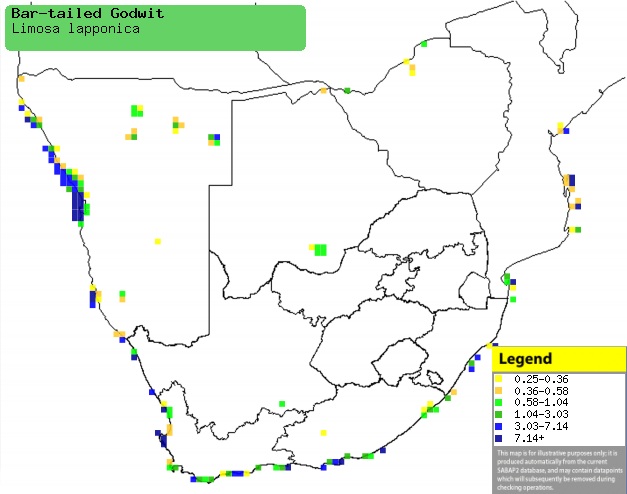|
Limosa lapponica (Bar-tailed
godwit)
Bandstertgriet [Afrikaans]; Rosse grutto [Dutch];
Barge hudsonienne [French]; Amerikanische Uferschnepfe [German]; Fuselo
[Portuguese]
Life
> Eukaryotes >
Opisthokonta
> Metazoa (animals) >
Bilateria >
Deuterostomia > Chordata >
Craniata > Vertebrata (vertebrates) > Gnathostomata (jawed
vertebrates) > Teleostomi (teleost fish) > Osteichthyes (bony fish) > Class:
Sarcopterygii (lobe-finned
fish) > Stegocephalia (terrestrial
vertebrates) > Tetrapoda
(four-legged vertebrates) > Reptiliomorpha > Amniota >
Reptilia (reptiles) >
Romeriida > Diapsida > Archosauromorpha > Archosauria >
Dinosauria
(dinosaurs) > Saurischia > Theropoda (bipedal predatory dinosaurs) >
Coelurosauria > Maniraptora > Aves
(birds) >
Order: Charadriiformes > Family: Scolopacidae
Distribution and habitat
Breeds along the margin of the Arctic Ocean, from northern
Scandinavia to west Alaska, migrating in the non-breeding season to the area
from Britain to Australasia south to the coast of Africa down to southern
Africa. Here it is uncommon to locally common along the coastline of the region,
especially central and northern Namibia, while more scare further inland. It
generally prefers estuaries, coastal lagoons and sheltered embayments,
occasionally moving to sandy beaches, coastal sewage works and commercial salt
pans.
|
 |
|
Distribution of Bar-tailed godwit in southern Africa,
based on statistical smoothing of the records from first SA Bird Atlas
Project (©
Animal Demography unit, University of
Cape Town; smoothing by Birgit Erni and Francesca Little). Colours range
from dark blue (most common) through to yellow (least common).
See here for the latest distribution
from the SABAP2. |
Movements and migrations
A non-breeding migrant, probably undertaking
the longest non-stop journey of any terrestrial bird, as one
subspecies travels 11 600 km from Alaska to New Zealand. It starts
arriving in southern Africa in October, with numbers peaking in
November before departing in March and April.
Food
It mainly eats polychaete worms, molluscs, crustaceans and
fish fry, doing most of its foraging in flocks, walking through mud or shallow
water, probing with its long bill in search of prey.
Threats
Not threatened.
References
-
Hockey PAR, Dean WRJ and Ryan PG 2005. Roberts
- Birds of southern Africa, VIIth ed. The Trustees of the John Voelcker
Bird Book Fund, Cape Town.
|
